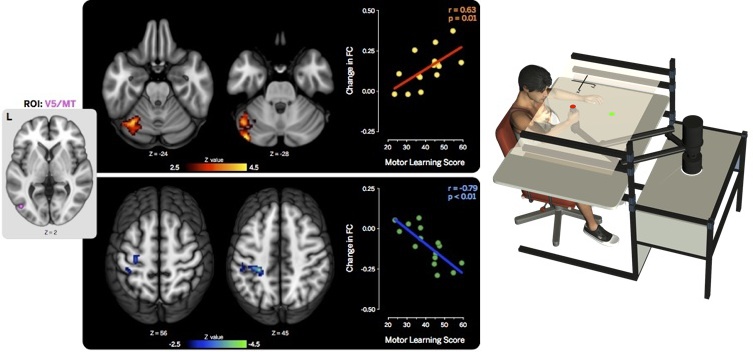Research
Campus Maps
Sensory Motor Neuroplasticity and Motor Learning
About Dr. Paul Gribble

Dr. Paul Gribble is a Professor in the Department of Psychology at Western University, and holds a joint appointment in the Department of Physiology and Pharmacology in the Schulich School of Medicine & Dentistry. Dr. Gribble’s research focuses on how the brain controls voluntary movement, and the relationship between neuroplasticity in sensory and motor brain areas and motor skill learning.
Despite the significant mechanical complexities of multi-joint limb movement, humans are able to interact with the environment with remarkable ease. A skilled athlete can accurately throw a light baseball or a heavy football even though the underlying muscle forces are very different. A skier can adjust leg muscle activity to manage complex contact forces with ice and snow, and a swimmer can learn to move efficiently in water. How does the brain learn the appropriate motor commands to limb muscles that take these loads into account? Research in the Gribble Lab is focused on understanding how the brain is organized to support motor learning, and how the central nervous system interacts with the complex peripheral neuromuscular plant to control skilled movement. Our studies focus on the control of multi-joint arm movements such as reaching.
Study Results
In one line of research we have been studying how neural mechanisms linking observation and action promote neuroplasticity in somatosensory and motor regions of the brain and facilitate learning novel motor skills. In a series of studies we have shown that as people observe another individual learning to move accurately in an unfamiliar mechanical environment (imposed on the arm by a computer-controlled robot), their brain begins to learn new neural representations of these novel forces. This “motor learning by observing” does not seem to depend on conscious awareness, but rather arises through the implicit engagement of sensory and motor areas of the brain—the same brain areas that are activated when we move our own body.
Recently we have used resting-state fMRI to study the neural basis of observational motor learning. We have identified a functional brain network involving the visual motion perception area V5/MT, cerebellum, dorsal premotor cortex, primary motor cortex and primary somatosensory cortex that underlies the brain’s ability to learn motor representations through observation. Activation in this network is significantly modulated by the amount of motor learning achieved through observation, as assessed behaviorally after resting-state fMRI scans. Furthermore, these changes are not explained by factors such as visual attention or observation of movement, but rather are specifically related to motor learning achieved through observation.

This functional brain network bridges the gap between visual systems for biological movement perception and sensory motor circuits for motor learning. This link enables us to map purely visual information about someone else’s movements onto our own motor system and form new motor representations of novel motor skills. This network may also represent a new therapeutic target for neuro-rehabilitation following stroke.
Other Topics
In the Gribble lab we carry out empirical studies using neurophysiological techniques such as fMRI, TMS, EEG, EMG and behavioural paradigms using robotic devices to create artificial mechanical environments. These empirical approaches are then combined with theoretical studies using computational models and computer simulations to test hypotheses about motor control, neuroplasticity and motor learning. Some of the other research topics in the lab include: how visual and somatosensory systems of the brain are modulated in concert with motor learning; computational models of how neural control signals to muscles are optimized for multi-joint movement; how the brain controls mechanical properties of the neuromuscular system such as limb stiffness.
References
Kistemaker DA, Van Soest AJ, Wong JD, Kurtzer I, Gribble PL (2013) Control of position and movement is simplified by combined muscle spindle and Golgi tendon organ feedback. J. Neurophysiol. 109:1126-39
Wong J, Wilson ET, Gribble PL (2011) Spatially Selective Enhancement of Proprioceptive Acuity Following Motor Learning. J. Neurophysiol. 105: 2512-21
Ostry DJ, Darainy M, Mattar AA, Wong J, Gribble PL (2010) Somatosensory plasticity and motor learning. J. Neurosci. 30(15): 5384-93
Brown LE, Wilson ET, Gribble PL (2009) Repetitive transcranial magnetic stimulation to the primary motor cortex interferes with motor learning by observing. J. Cogn. Neurosci. 21(5): 1013-22
Mattar AA, Gribble PL (2005) Motor learning by observing. Neuron 46(1): 153-60

